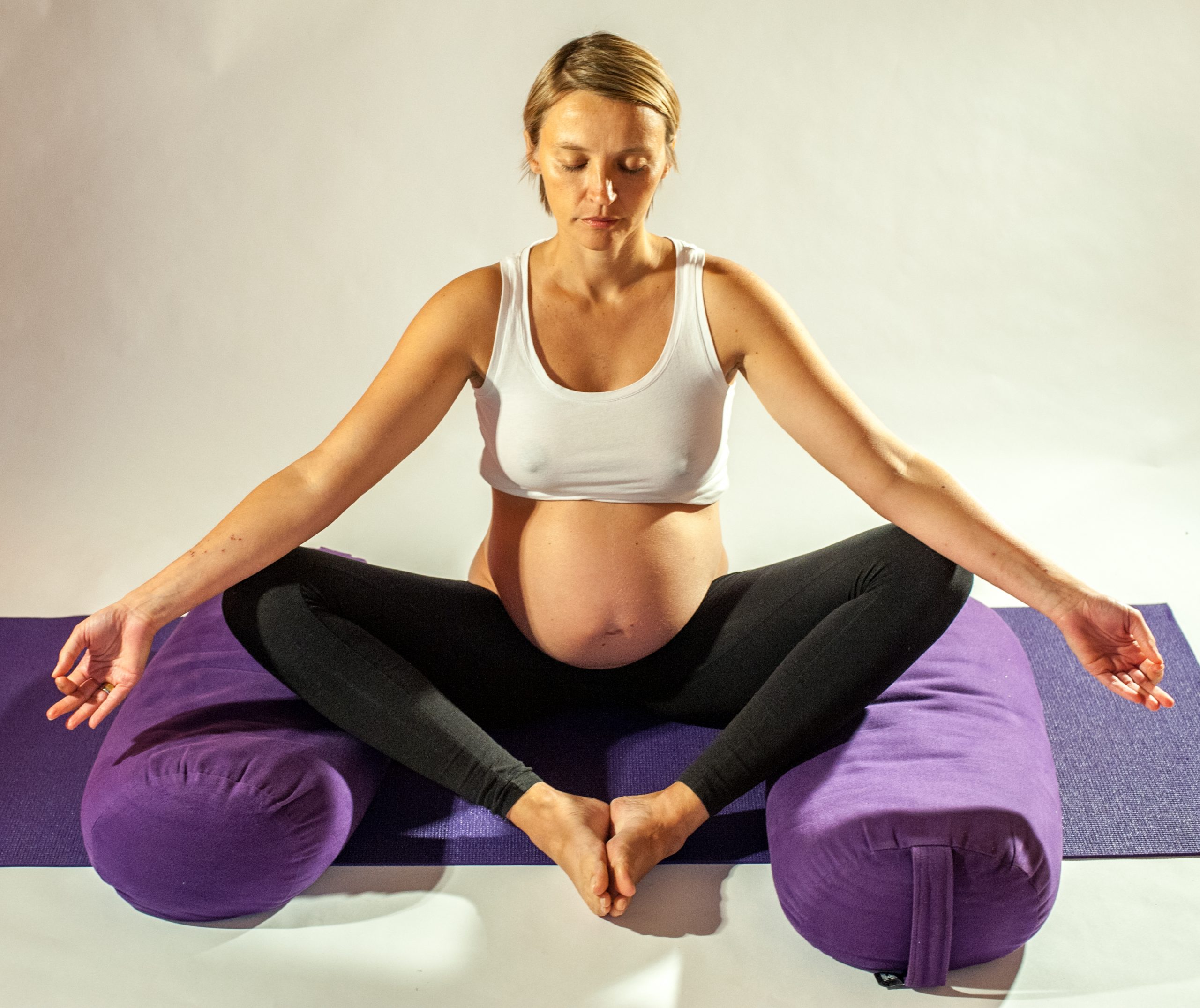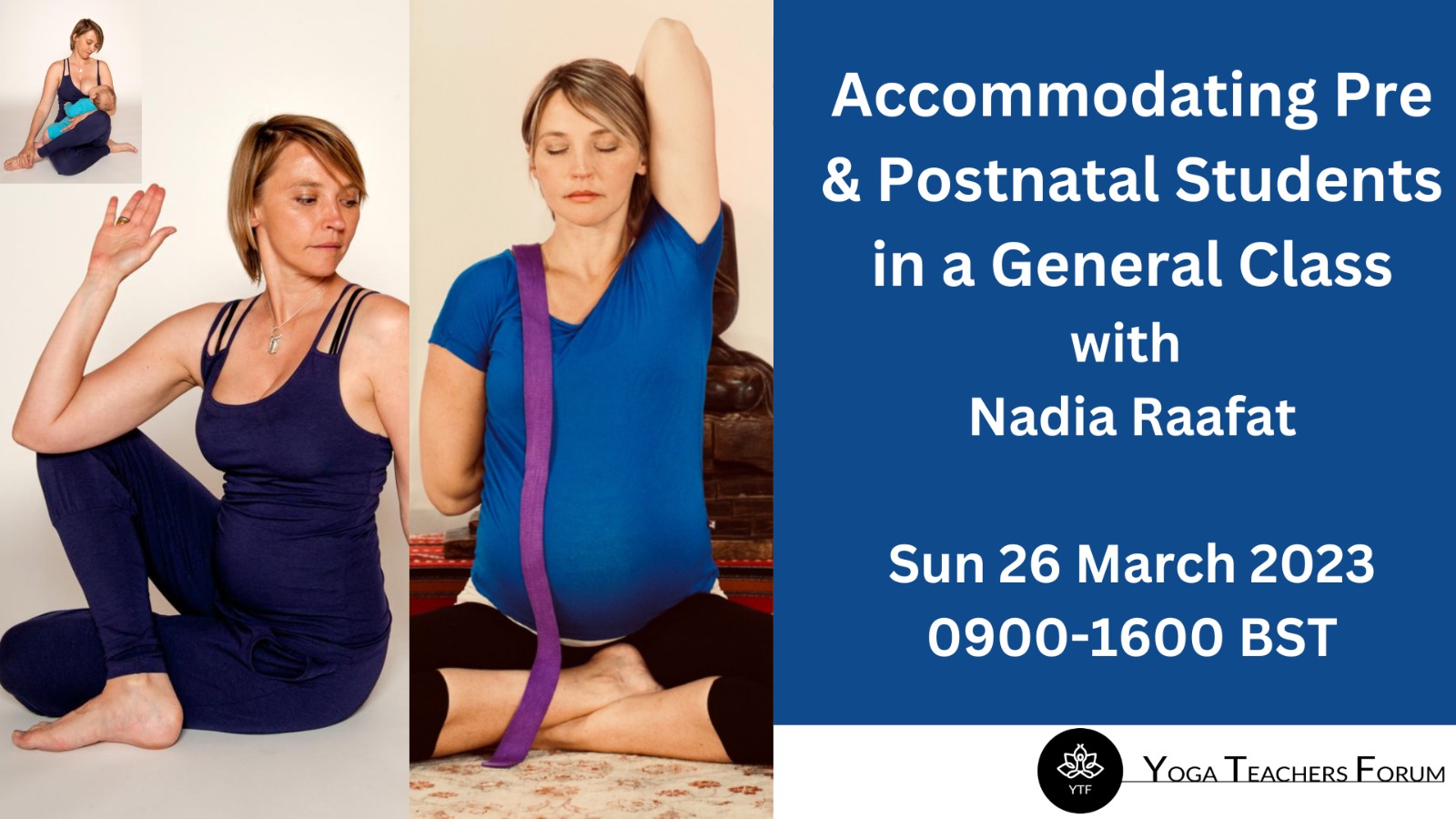How to Keep Pregnant Students Safe In Your General Yoga Classes
Six Recommendations for Best Practice

This week I had two pregnant students in my general yoga classes; one was 26 weeks; second pregnancy, dog-tired but keen to move, stretch and release; the other was 36 weeks also second pregnancy; also tired but keen to down-regulate and find inner steadiness before the birth.
Both were in my classes for different reasons; one preferred the late night timing of the class; the other preferred to stay with me in a general class rather than switch to a pregnancy class with an unknown teacher. As I am a pregnancy specialist , I felt very comfortable with both of them being there and keeping their practice effective, satisfying and safe without compromising the other students.
There are many reasons why pregnant (and postnatal) students) may prefer to remain in your general class than switch to or find a pregnancy class. The first one being that pregnancy yoga only starts at 14 weeks. So where is a pregnant yoga student supposed to go during her first trimester?
Not only that but most pregnant students prefer to join pregnancy yoga classes later on in their pregnancies when they are ready for the inevitable birth ed. that accompanies many pregnancy yoga classes or until they have a sizeable bump that makes their regular practice more challenging. Add in the fact that students often cannot access a class; the timings are wrong or they simply know and love their teacher and you can see why pregnant students in general classes is an increasingly common phenomenon.
However as many 200 hour teacher trainings do not even mention the word pregnancy, it is hardly surprising that many teachers express a nervousness about hosting a pregnant student and their gestating foetus in their yoga class with little or no knowledge of the special state of pregnancy..
If you are not a pregnancy specialist, there may be much that you are unaware of about the pregnancy experience and how it informs yoga practice.
Pregnancy comes with a LOT of change; structural, psychological, physiological and of course emotional. It also comes with a lot of side-effects too; from shortness of breath to dizziness and from loose ligaments to lax blood vessel walls. Any teacher who welcomes a pregnant student into their regular class needs to have a basic understanding of the physiology of pregnancy and how it impacts yoga practice so that your student is safe in your classes.
Pregnant women are generally advised not to attend a yoga class before 14 weeks gestation, when the pregnancy is considered to be established. This is why pregnancy yoga classes start at 14 weeks. However for many women abandoning their yoga practice at a time when they need it most is unhelpful advice and can lead to a decrease in wellbeing. If your student has a regular practice, it is safe for her to continuer her practice during the first trimester as you both understands the contraindications of the first trimester and practice safely and mindfully.
First Trimester and Yoga
Safe Yoga practice in the first trimester comprises nourishing gentle yoga, gentle pranayama, and relaxation. In fact many postures – and whole groups of postures – are contraindicated in this delicate first trimester including:
- Inversions
- Deep Twists
- Floor Based Prone Positions
- Dynamic Pranayama like kappalabharti or bastrika breathing.
- Deep backbends
- Jump-backs and Lean-backs
These all bring, in very different ways, unnecessary pressure to the abdominal and pelvic cavity where the placenta is establishing itself

So when a pregnant student comes into your class or a regular student announces her pregnancy, Here are six key steps for you to take to ensure that she is safe in your class:
1. Offer Your Pregnant Students a Pregnancy Health Registration Form
Here are some of the things you need to find out from your pregnant student:
- Which trimester are they in? It helps to know this as different modifications are offered for different trimesters.
- What was their pre-pregnancy yoga practice like. Pregnant students will relate differently to their practice and their bodies; an astanga practitioner with 10 years experience will want something different form her yoga practice to a Restorative yogi with much less experience. We need to respect our students relationship with tenor own bodies. Knowing their practice will help us to accurately modify their practice for pregnancy.
- Have they had any injuries? A key question for pregnancy as the destabilisation often pregnant body often means old injuries can resurface and cause pain and discomfort.
- Are they suffering from any of the side effects of the pregnancy? Yoga offers many remedies for pregnancy ailments however yoga can also harm the pregnant body if it is practiced without awareness of the necessary modifications for many pregnancy conditions.
- How would they describe their emotional state? Antenatal anxiety and antenatal depression are very real and can really impact the pregnancy. Having this infuriation will help yu to construct a practice that meets and supports the needs so your pregnancy student.
- Have they informed their midwife or doctor that they are practising yoga?
- Please get them to sign a disclaimer on the form accepting full responsibility for their pregnancy yoga practice.
This form needs revising throughout the pregnancy as pregnancy is a transitional rather than fixed state marked by many changes. I recommend a revisit at the beginning of the second trimester and again at the beginning of the third trimester if your pregnant student is still in your general yoga class.
2. Keep Your Student Close By Where You Can Keep an Eye of Her
I place my pregnant students at the front of the room. That way I can see if she is struggling or over-reaching. I can easily remind her to slow down and I can check in with her after the class.
3.Go Through Your Modifications with Your Pregnant Student BEFORE the class starts.
Learn which poses are not recommended prenatally and what you can offer as an alternative. Have you general lesson plan and your modified lesson plan. Share it with her before the class starts. That way she knows what she is doing and you can flow with your general lesson plan without Interruption.
What are Some of the Key modifications?:
Taking a blanket approach to postures during pregnancy can be limiting as what is contraindicated in one trimester may be available again in another. For example modified inversions can return again in the second trimester and remain until the second half of the third trimester when they are again inappropriate.
Yoga Poses that are Contraindicated During Pregnancy:
- Closed twists – if your class features any closed twists, offer an open twist or upper body thoracic twist instead
- Deep backbends – during pregnancy, place too much pressure on the rectus abdomens which can cause severe diastasis rectus abdominus or DRA – practice gentle backbends like modified ustrasana, modified sphinx or modified matsyasana instead..
- Inversions -instead of attempting shoulder stands or handstands in the first and third trimesters offer viparita karani (legs up the wall) with a bolster or blanket underneath the hips which is much more sustainable and great for pregnancy circulation.
- Core work – avoid postures that involve flexing or crunching the abdominal wall – poses like navasana (boat pose) should be avoided during pregnancy. Instead practice gentle core support with hand knee balance, modified plank or dolphin pose instead.
- Dynamic pranayama like Bastrika or Kappalabharti are contraindicated as are breath holds as they can cause dizziness – which is already an issue in pregnancy.
4. Props are Essential for Pregnant Yoga Practitioners
When it comes to making your yoga classes accessible for pregnant students, props are essential. Props help to create more space within postures and offer extra stability and support.
Your pregnant student will probably need to use blocks, bolsters and possibly blankets and straps at some point in order to continue practicing with comfort and safety.
5. Encourage Prenatal Students to Slow Right Down and Practice With Kindness and Awareness.
Given the guidance to pregnant women to practice only relaxation, breath work and meditation in the first trimester, this is particularly important for the first 14 weeks when there is no belly and you could easily forget they are pregnant at all.
They need to practice according to how they feel on that day, not according to what the rest of the class is doing. Practicing fro s place of embodied awareness, meeting the needs of the body and trusting the body’;s feedback will prepare them well for the experience of labour and mothering after birth when instincts are string and informative.
Encourage your student to be mindful of the changes in their blood pressure. Particularly if your class includes sun salutations, or flowing sequences, invite them to transition slowly and pause for a breath half way when rising back up to standing or descending.
Remind them not to push too far in stretches, practice kindness towards the structural body and take a step back if there’s anything that doesn’t feel right for them.
6. Keep Your Pregnant Students Close
At the front of the class they won’t be tempted to copy other students.
You can keep an eye on them and remind them to practice at their own pace.
You can easily check in with them after the class and find our how their experience was.
What if a Pregnant Student Comes to an Online General Class?
With so many classes happening online, it’s important to be extra diligent if pregnant students are in the virtual yoga studio.
Make sure that your student has notified their health care provider and filled in the health form and signed the disclaimer.
Remind them to bring their props as they will need them. Chairs and books, blankest and pillow can work just as well as traditional yoga props.
You will still need to offer them the necessary modifications.
They can notify you via the chat of any pregnancy updates without sharing that info with the rest of the class.
Do check in with them before and after the class. A follow up email is also a good idea if you feel that you are not in touch with them during the class itself.
The good news is you do not need to be a prenatal specialist to host a pregnant student in your class however equipping yourself with basic pregnancy anatomy and physiology, knowledge of the three trimesters and how they impact yoga practice and knowledge of the contraindicated postures and their modifications will help you to feel confident in the seat of teacher.
That way you know you will be holding a safe and welcoming space for that pregnant yoga student who has chosen to practice with you during a key transition period in her life.
Nadia Raafat is teaching a 1-Day Online workshop this March on: The Safe Accommodation of Pre and Post Natal Students into your Regular Yoga Classes
Saturday 21 October 9am-5pm (ONLINE& RECORDED)
Hosted by Nadia Raafat Yoga Birth + Yoga Teachers Forum
All students will receive access to the slide presentations, class recordings and accompanying course materials
Cost £85
Booking is via the YogaTeachers Forum



